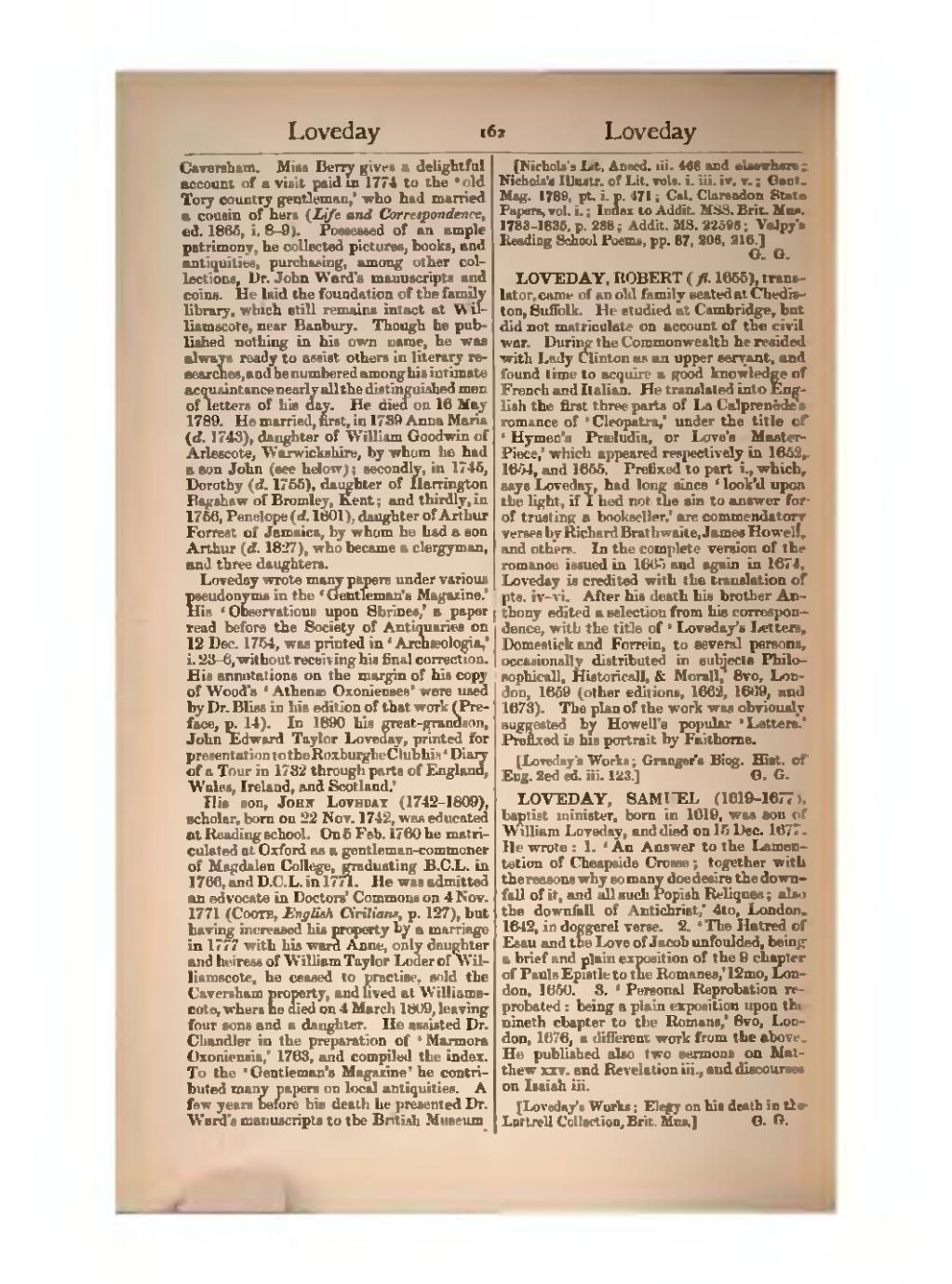Caversham. Miss Berry gives a delightful account of a visit paid in 1774 to the ‘old Tory country gentleman,’ who had married a cousin of hers (Life and Correspondence, ed. 1865, i. 8–9). Possessed of an ample patrimony, he collected pictures, books, and antiquities, purchasing, among other collections, Dr. John Ward's manuscripts and coins. He laid the foundation of the family library, which still remains intact at Williamscote, near Banbury. Though he published nothing in his own name, he was always ready to assist others in literary researches, and he numbered among his intimate acquaintance nearly all the distinguished men of letters of his day. He died on 16 May 1789. He married, first, in 1739 Anna Maria (d. 1743), daughter of William Goodwin of Arlescote, Warwickshire, by whom he had a son John (see below); secondly, in 1745, Dorothy (d. 1755), daughter of Harrington Bagshaw of Bromley, Kent; and thirdly, in 1756, Penelope (d. 1801), daughter of Arthur Forrest of Jamaica, by whom he had a son Arthur (d. 1827), who became a clergyman, and three daughters.
Loveday wrote many papers under various pseudonyms in the ‘Gentleman's Magazine.’ His ‘Observations upon Shrines,’ a paper read before the Society of Antiquaries on 12 Dec. 1754, was printed in ‘Archæologia,’ i. 23–6, without receiving his final correction. His annotations on the margin of his copy of Wood's ‘Athenæ Oxonienses’ were used by Dr. Bliss in his edition of that work (Preface, p. 14). In 1890 his great-grandson, John Edward Taylor Loveday, printed for presentation to the Roxburghe Club his ‘Diary of a Tour in 1732 through parts of England, Wales, Ireland, and Scotland.’
His son, John Loveday (1742–1809), scholar, born on 22 Nov. 1742, was educated at Reading school. On 5 Feb. 1760 he matriculated at Oxford as a gentleman-commoner of Magdalen College, graduating B.C.L. in 1766, and D.C.L. in 1771. He was admitted an advocate in Doctors' Commons on 4 Nov. 1771 (Coote, English Civilians, p. 127), but having increased his property by a marriage in 1777 with his ward Anne, only daughter and heiress of William Taylor Loder of Williamscote, he ceased to practise, sold the Caversham property, and lived at Williamscote, where he died on 4 March 1809, leaving four sons and a daughter. He assisted Dr. Chandler in the preparation of ‘Marmora Oxoniensia,’ 1763, and compiled the index. To the ‘Gentleman's Magazine’ he contributed many papers on local antiquities. A few years before his death he presented Dr. Ward's manuscripts to the British Museum.
[Nichols's Lit. Anecd. iii. 468 and elsewhere; Nichols's Illustr. of Lit. vols. i. iii. iv. v.; Gent. Mag. 1789, pt. i. p. 471; Cal. Clarendon State Papers, vol. i.; Index to Addit. MSS. Brit. Mus. 1783–1835, p. 288; Addit. MS. 22596; Valpy's Reading School Poems, pp. 87, 206, 216.]
LOVEDAY, ROBERT (fl. 1655), translator, came of an old family seated at Chediston, Suffolk. He studied at Cambridge, but did not matriculate on account of the civil war. During the Commonwealth he resided with Lady Clinton as an upper servant, and found time to acquire a good knowledge of French and Italian. He translated into English the first three parts of La Calprenède's romance of ‘Cleopatra,’ under the title of ‘Hymen's Præludia, or Love's Master-Piece,’ which appeared respectively in 1652, 1654, and 1655. Prefixed to part i., which, says Loveday, had long since ‘look'd upon the light, if I had not the sin to answer for of trusting a bookseller,’ are commendatory verses by Richard Brathwaite, James Howell, and others. In the complete version of the romance issued in 1665 and again in 1674, Loveday is credited with the translation of pts. iv–vi. After his death his brother Anthony edited a selection from his correspondence, with the title of ‘Loveday's Letters, Domestick and Forrein, to several persons, occasionally distributed in subjects Philosophicall, Historicall, & Morall,’ 8vo, London, 1659 (other editions, 1662, 1669, and 1673). The plan of the work was obviously suggested by Howell's popular ‘Letters.’ Prefixed is his portrait by Faithorne.
[Loveday's Works; Granger's Biog. Hist. of Eng. 2nd ed. iii. 123.]
LOVEDAY, SAMUEL (1619–1677), baptist minister, born in 1619, was son of William Loveday, and died on 15 Dec. 1677. He wrote: 1. ‘An Answer to the Lamentation of Cheapside Crosse; together with the reasons why so many doe desire the downfall of it, and all such Popish Reliques; also the downfall of Antichrist,’ 4to, London, 1642, in doggerel verse. 2. ‘The Hatred of Esau and the Love of Jacob unfoulded, being a brief and plain exposition of the 9 chapter of Pauls Epistle to the Romanes,’ 12mo, London, 1650. 3. ‘Personal Reprobation reprobated: being a plain exposition upon the nineth chapter to the Romans,’ 8vo, London, 1676, a different work from the above. He published also two sermons on Matthew xxv. and Revelation iii., and discourses on Isaiah iii.
[Loveday's Works; Elegy on his death in the Luttrell Collection, Brit. Mus.]
